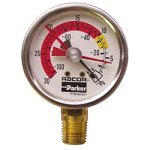I installed new Racor gauges in an effort to narrow down my surging issue on my Stb engine. I had generic gauges installed a few years ago but they didn’t last and I like the way these new ones “hold” the high reading. As usual, the results are not clear. To recap, my Stb engine has a surge around 1,500 RPM’s of 200RPM’s. It’s a steady up and down. It’s also cutting out at very high RPM’s (near WOT) and the fuel pressure is low according to the numbers I got from my gauge. I have an early 8.1 so it’s just the single fuel pump, not a high and low. The spec numbers I found are not specifically for my year, I’m assuming they would be the same regardless. It’s low at the higher end, idle spec is fine.With the gauges installed, I started the STB engine and the gauge is reading around 2hg and stayed there with some quick revs up and down. Clearly not in the red or even yellow so I thought that was ok. On the port engine, which has no issues, the gauge almost immediately shot into the Red and was 15 with a quick rev up to around 2,000 RPM’s.
That is way into the red on the scale. There is clearly a difference between the two engines but it’s the opposite of what I would expect with a fuel pressure issue. I have two tanks and they’re running independently. I’m not sure what to do next….(This is what the gauge looks like)…. Thanks Bob.
ok, forget all of that! I left the crossover valve closed on the PORT engine when i installed the gauge the other night. That one is reading about 2hg at idle. I’ll compare the two with my next run.
That is way into the red on the scale. There is clearly a difference between the two engines but it’s the opposite of what I would expect with a fuel pressure issue. I have two tanks and they’re running independently. I’m not sure what to do next….(This is what the gauge looks like)…. Thanks Bob.
ok, forget all of that! I left the crossover valve closed on the PORT engine when i installed the gauge the other night. That one is reading about 2hg at idle. I’ll compare the two with my next run.
Attachments
Last edited:


